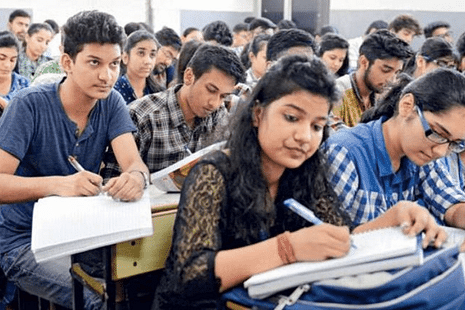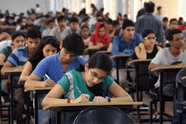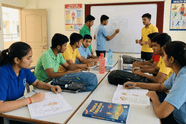Chapter -1 Relations and Functions
| -
If f: R → R is defined by f(x) = (2x – 3) / (x + 4), show that f is bijective and determine its inverse.
-
Consider the set Z of all integers with the relation R defined by a R b if a ≡ b (mod 5). Identify all distinct equivalence classes of R.
-
Find all functions f: R → R such that f(x + y) = f(x) + f(y) for all x, y ∈ R.
|
Chapter -2 Inverse Trigonometric Functions
| -
Prove that 2 tan⁻¹(x) = sin⁻¹(2x / (1 + x²)) for |x| < 1.
-
Evaluate: tan(sin⁻¹(1/2)).
-
Find the principal value of cos⁻¹(-1/2).
-
Differentiate y = tan⁻¹((√(1 + x²) – 1) / x) with respect to x.
-
Show that sin⁻¹(x) + sin⁻¹(y) = sin⁻¹(x√(1 – y²) + y√(1 – x²)) for x, y ∈ [-1/√2, 1/√2] and x² + y² ≤ 1.
|
Chapter -3 Matrices
| -
Solve for X: AX = B, where A = [[1, 2], [3, 4]] and B = [[5], [6]].
-
If A is a square matrix such that A² - 5A + 6I = 0, find A⁻¹ in terms of A.
-
If A = [[cosθ, -sinθ], [sinθ, cosθ]], show that Aᵀ A = I.
-
Prove that for any square matrix A, (A + Aᵀ) is always symmetric.
|
Chapter -4 Determinants
| -
If A = [[2, 3], [4, 5]], find det(A).
-
If A = [[1, 2, 3], [4, 5, 6], [7, 8, 9]], show that det(A) = 0.
-
Using determinants, check if the given system of equations has a unique solution:
2x + 3y = 5
4x + 6y = 10
|
Chapter -5 Continuity and Differentiability.
| -
Check the continuity of the function f(x) = (x² - 4) / (x – 2) at x = 2.
-
If f(x) = e^x * ln(x), find f’(x).
-
Verify that f(x) = |x – 3| is not differentiable at x = 3.
-
If y = x^x, find dy/dx using logarithmic differentiation.
|
Chapter -6 Applications of Derivatives.
| -
Find the intervals where the function f(x) = x³ - 6x² + 9x + 1 is increasing or decreasing.
-
Find the point on the curve y = x² - 4x + 6 where the tangent is parallel to the x-axis.
-
Show that the function f(x) = x³ - 12x + 5 has only one real root.
-
A manufacturer produces x units of a product at a cost C(x) = x³ - 6x² + 15x. Find the marginal cost when x = 3.
|
Chapter -7 Integrals
| -
Find: ∫ (x / (x² + 1)) dx.
-
Solve: ∫ (1 / (1 + x²)) dx.
-
Find: ∫ (x ln x) dx using integration by parts.
-
Solve the definite integral: ∫ from 0 to π/2 of sinx cosx dx
|
Chapter -8 Application of Integrals.
| -
Find the area enclosed between the curves y = x² and y = 2x.
-
Evaluate the area of the region bounded by y = sinx, the x-axis, and the lines x = 0 and x = π.
-
Find the area of the circle x² + y² = 4 lying in the first quadrant.
|
Chapter -9 Differential Equations
| -
Form the differential equation representing the family of curves: y = ax + b, where a and b are arbitrary constants.
-
Solve the equation: (x + y) dy = (x – y) dx.
-
Verify that y = c e^(-x²) is a solution of dy/dx + 2xy = 0.
|
Chapter -10 Vector algebra
| -
Find the value of λ if the vectors a = (1, λ, 3) and b = (2, 4, 6) are parallel.
-
Find the projection of the vector a = (5, -2, 3) on b = (1, 2, -1).
-
If p = (2, -1, 4) and q = (-3, 5, 1), find the vector that is perpendicular to both p and q and has magnitude 10.
|
Chapter -11 Three dimensional geometry
| -
Determine whether the lines (x – 1)/2 = (y + 3)/3 = (z – 4)/1 and (x + 2)/4 = (y – 1)/6 = (z + 5)/2 are parallel, intersecting, or skew.
-
Find the shortest distance between the lines x = 2 + λ, y = 3 – 2λ, z = 4 + λ and x = 1 + μ, y = -1 + 2μ, z = 5 + 3μ.
-
Find the angle between the planes x – y + 2z = 4 and 2x + y – 3z = 5.
|
Chapter -12 Linear Programming
| -
A company manufactures two types of belts: standard and premium. The profit on a standard belt is ₹50, and on a premium belt is ₹80. The company can produce at most 40 belts in a day, and the total working hours available are 100 hours. The standard belt takes 2 hours to manufacture, and the premium belt takes 5 hours. Formulate the problem as an LPP to maximize profit.
-
A farmer has a total of 10 hectares of land to grow wheat and barley. The profit per hectare for wheat is ₹5000, and for barley is ₹3000. Due to crop rotation requirements, at most 6 hectares can be used for wheat, and at least 2 hectares must be used for barley. Formulate a linear programming problem to maximize profit.
-
A dietitian wants to prepare a food supplement containing proteins and carbohydrates. Each unit of ingredient A contains 5g of protein and 10g of carbohydrates, and each unit of ingredient B contains 8g of protein and 6g of carbohydrates. The supplement should contain at least 40g of protein and at most 60g of carbohydrates. Formulate an LPP to minimize the cost, assuming ingredient A costs ₹4 per unit and ingredient B costs ₹5 per unit.
-
A factory produces two types of chairs: wooden and plastic. The wooden chair requires 4 hours of labor, and the plastic chair requires 3 hours. The total available labor is 120 hours. The profit per wooden chair is ₹100, and the profit per plastic chair is ₹80. Formulate an LPP to maximize profit.
|
Chapter -13 Probability
| -
Two fair dice are rolled. Find the probability that the sum of the numbers obtained is at most 8.
-
A committee of 3 members is to be formed from 4 men and 5 women. Find the probability that the committee has at least one woman.
-
If the probability that a student passes Mathematics is 0.75, and the probability that they pass Science is 0.65, and the probability that they pass both is 0.50, find the probability that the student passes at least one subject.
-
A and B are two mutually exclusive events. If P(A) = 0.35 and P(B) = 0.45, find P(A ∪ B).
|
 CBSE Class 12 Mathematics Expected Question Paper 2025
CBSE Class 12 Mathematics Expected Question Paper 2025





 Follow us
Follow us















